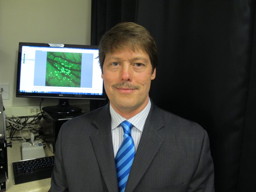Home > Press > UAlberta prostate cancer researcher and team developing 'homing beacon drugs' to target cancer cells
 |
Abstract:
A medical researcher with the University of Alberta and his team just published their findings about their work on developing 'homing beacon drugs' that kill only cancer cells, not healthy ones, thanks to nano-technology.
UAlberta prostate cancer researcher and team developing 'homing beacon drugs' to target cancer cells
Edmonton, Canada | Posted on November 21st, 2012John Lewis, the Frank and Carla Sojonky Chair in Prostate Cancer Research with the Faculty of Medicine & Dentistry, published his findings in the peer-reviewed journal, Nano Letters. He is also an associate professor in the Department of Oncology, a Fellow with the National Institute for Nanotechnology at the U of A and director of the Translational Prostate Cancer Research Group.
Lewis noted chemotherapy goes through the body and kills any cells that are dividing, even healthy ones - which is why cancer patients have immune system problems, hair loss, nausea and skin problems.
"We are developing smart drugs that determine which are the cancer cells and which aren't, then selectively kill only the cancer cells. The drugs look for a protein that is only found in cancer cells, not normal cells. This system acts like a homing beacon for tumours."
These drugs, tested to date in only animal lab models, could be used within a week of cancer diagnoses, predicts Lewis. The drugs would target cancerous cells throughout the body - attacking sneaky cancer cells that have already escaped and grown outside the site of the main tumour.
Lewis wasn't sure when these homing beacon drugs could be available for physicians to use with patients, but hopes his works paves the way for patient-centered therapies.
"If we can use 'smart' drugs that home in on tumours, we can dramatically decrease side effects for patients, lower the chance of recurrence, and hopefully increase the cancer survival rate."
Meanwhile, Lewis and his research team are continuing their work on trying to figure out what causes cancer cells to escape and spread from the main tumour site because the cells that move are different than the ones in the main tumour. They have pinpointed numerous genes that set these 'moving' cancer cells apart from the ones that stay put. Based on this research, they have come up with a drug that uses a 'tumour glue' to prevent these moving cancer cells from breaking apart from the main tumour, which prevents the spread of the cancer. Using knowledge gained from the 'tumour glue' drug, Lewis and his team are working to develop new blood tests to predict whether prostate and other cancers will spread.
####
For more information, please click here
Contacts:
Raquel Maurier
780-492-5986
Copyright © University of Alberta Faculty of Medicine & Dentistry
If you have a comment, please Contact us.Issuers of news releases, not 7th Wave, Inc. or Nanotechnology Now, are solely responsible for the accuracy of the content.
| Related News Press |
News and information
![]() Researchers develop molecular qubits that communicate at telecom frequencies October 3rd, 2025
Researchers develop molecular qubits that communicate at telecom frequencies October 3rd, 2025
![]() Next-generation quantum communication October 3rd, 2025
Next-generation quantum communication October 3rd, 2025
![]() "Nanoreactor" cage uses visible light for catalytic and ultra-selective cross-cycloadditions October 3rd, 2025
"Nanoreactor" cage uses visible light for catalytic and ultra-selective cross-cycloadditions October 3rd, 2025
Govt.-Legislation/Regulation/Funding/Policy
![]() New imaging approach transforms study of bacterial biofilms August 8th, 2025
New imaging approach transforms study of bacterial biofilms August 8th, 2025
![]() Electrifying results shed light on graphene foam as a potential material for lab grown cartilage June 6th, 2025
Electrifying results shed light on graphene foam as a potential material for lab grown cartilage June 6th, 2025
![]() Institute for Nanoscience hosts annual proposal planning meeting May 16th, 2025
Institute for Nanoscience hosts annual proposal planning meeting May 16th, 2025
Nanomedicine
![]() New molecular technology targets tumors and simultaneously silences two ‘undruggable’ cancer genes August 8th, 2025
New molecular technology targets tumors and simultaneously silences two ‘undruggable’ cancer genes August 8th, 2025
![]() New imaging approach transforms study of bacterial biofilms August 8th, 2025
New imaging approach transforms study of bacterial biofilms August 8th, 2025
![]() Cambridge chemists discover simple way to build bigger molecules – one carbon at a time June 6th, 2025
Cambridge chemists discover simple way to build bigger molecules – one carbon at a time June 6th, 2025
![]() Electrifying results shed light on graphene foam as a potential material for lab grown cartilage June 6th, 2025
Electrifying results shed light on graphene foam as a potential material for lab grown cartilage June 6th, 2025
Discoveries
![]() Researchers develop molecular qubits that communicate at telecom frequencies October 3rd, 2025
Researchers develop molecular qubits that communicate at telecom frequencies October 3rd, 2025
![]() Next-generation quantum communication October 3rd, 2025
Next-generation quantum communication October 3rd, 2025
![]() "Nanoreactor" cage uses visible light for catalytic and ultra-selective cross-cycloadditions October 3rd, 2025
"Nanoreactor" cage uses visible light for catalytic and ultra-selective cross-cycloadditions October 3rd, 2025
Announcements
![]() Rice membrane extracts lithium from brines with greater speed, less waste October 3rd, 2025
Rice membrane extracts lithium from brines with greater speed, less waste October 3rd, 2025
![]() Researchers develop molecular qubits that communicate at telecom frequencies October 3rd, 2025
Researchers develop molecular qubits that communicate at telecom frequencies October 3rd, 2025
![]() Next-generation quantum communication October 3rd, 2025
Next-generation quantum communication October 3rd, 2025
![]() "Nanoreactor" cage uses visible light for catalytic and ultra-selective cross-cycloadditions October 3rd, 2025
"Nanoreactor" cage uses visible light for catalytic and ultra-selective cross-cycloadditions October 3rd, 2025
|
|
||
|
|
||
| The latest news from around the world, FREE | ||
|
|
||
|
|
||
| Premium Products | ||
|
|
||
|
Only the news you want to read!
Learn More |
||
|
|
||
|
Full-service, expert consulting
Learn More |
||
|
|
||








